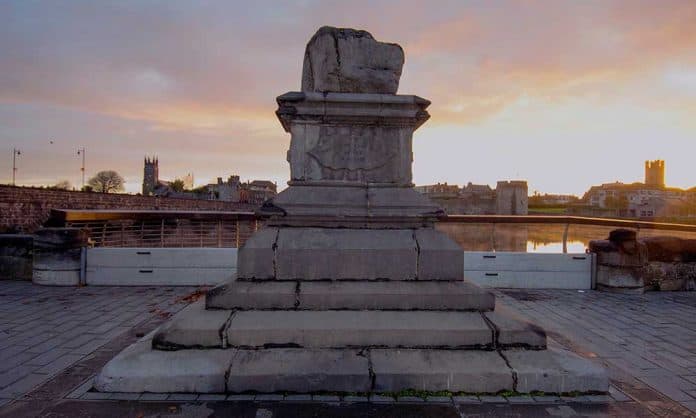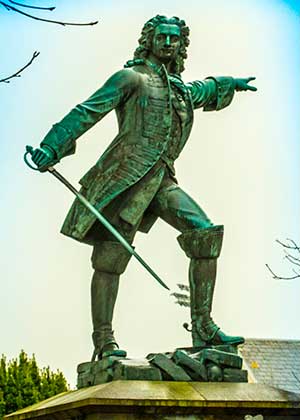
The Treaty Stone in Limerick, widely believed to be the setting for the signing of the Treaty of Limerick, is hugely significant in Irish history.
The signing of the treaty ended the Siege of Limerick and signalled the conclusion of the war between William of Orange supporters and the Jacobites.
The treaty was signed by important historical figures, including Patrick Sarsfield, Earl of Lucan.
History of the Treaty Stone and the Treaty of Limerick
The long and fascinating history of the Treaty Stone has many twists and turns, including the fate of the soldiers referred to in the Flight of the Wild Geese.
Here we aim to outline the history of the Treaty Stone and the treaty itself, as well as discuss the individuals instrumental in the signing of the treaty, including Patrick Sarsfield, Le Chevalier de Tessé and D’Usson.
The stories of the soldiers who emigrated to mainland Europe in the Flight of Wild Geese will also be explored, as will the background of the Jacobite resistance to William of Orange and the importance of the Siege of Limerick.
Background to the Treaty of Limerick
Protestants William of Orange and Mary, his wife, became the King and Queen of England, Scotland and Ireland in 1689, replacing the the Catholic James II.
The Williamite War, or Jacobite War, was fought between William’s supporters and the Jacobites, who supported James II.
James and his forces planned to take control of Ireland and use the country as a base from which to take back control of the rest of his kingdom.
The French army supported James in the war, and the war eventually became part of Europe’s Nine Years’ War.
While James’s support was predominately Catholic, he did have some Protestant supporters in Ireland too.
William’s army won the Battle of the Boyne in 1690, and William followed it with the Declaration of Finglas, designed to pardon Jacobite soldiers but not senior officers.
As a result, the Jacobite military leaders continued to fight and scored an important victory in the second of the Sieges of Limerick in 1691.
Further battles, however, were won by the Williamites, and the Treaty of Limerick was drafted in an attempt to bring an end to the conflict.
The Treaty offered far more generous terms to the Jacobite military leaders than the Declaration of Finglas had just one year earlier.
The Treaty of Limerick
The treaty was actually two treaties – the Civil Articles and the Military Articles.
They are usually referred to as a single treaty, and both were signed on the same day – 3rd October 1691.
Each treaty consisted of a number of articles, and each was signed by a number of important figures.
The Civil Articles
The Civil Articles consisted of a total of 13 articles agreed upon by the following:
- the Right Honourable Sir Charles Porter
- his Excellency the Baron de Ginkel, Lieutenant General and the English army’s Commander-in-Chief
- Thomas Coningsby, 1st Earl Coningsby, Lord Justice of Ireland
- Piers, Viscount Galmoy; Colonel Nicholas Cusack
- Colonel Nicholas Purcell of Loughmoe
- Sir Toby Butler, who drafted it
- the Right Honourable Patrick Sarsfield, Earl of Lucan
- Colonel John Brown
- Colonel Garrett Dillon
These articles were signed by Thomas Coningsby, Charles Porter and Baron de Ginkel and witnessed by Scavenmoer, H. Mackay, and T. Talmash.
This Treaty was signed in order to protect the rights of the Jacobite landed gentry, who had been defeated and chose to remain living in Ireland.
Most of this group were Catholics, and the Treaty ensured their property would not be confiscated.
In order to receive these guarantees, the Jacobites had to declare their allegiance to William III and Mary II. The treaty also gave them the right to bear arms.
It was not long, however, before the Treaty was broken by the English – the victorious Williamites did not honour it.
Those Catholic landowners who had sworn allegiance between 1691 and 1693 did remain protected, though, as did their descendants.
From 1693, James II was recognised by the Papacy as the rightful King of Ireland, and from 1695, a number of harsh laws were enacted by the Irish parliament.
These laws, known as the Penal Laws, made it difficult for members of the gentry who had not declared their allegiance by this time to remain as practising Catholics.
During the War of the Spanish Succession, which lasted from 1701 to 1714, these laws were extended; it wasn’t until the 1770s that reforms began.
The Military Articles
The Military Articles consisted of 29 articles in total.
These articles were agreed upon by the following:
- Lieutenant-General de Ginkel, the English army’s Commander-in-Chief
- Lieutenant-Generals de Tessé and D’Usson, Commanders-in-Chief of the Irish army
The treaty was signed by
- Patrick Sarsfield, Earl of Lucan
- Lieutenant-General D’Usson
- Lieutenant-General de Tessé
- Latour Montfort; Piers, Viscount Galmoy
- Colonel Nicholas Purcell of Loughmoe
- Mark Talbot
This treaty focused on the disbanded Jacobite army and the treatment soldiers would receive.
According to the terms of the treaty, Jacobite soldiers from formed regiments would be allowed to leave for France in order to continue fighting for the Irish Brigade of James II.
Around 14,000 of the soldiers chose this option, and sailed from Cork to France.
Many soldiers took their entire families with them, including their children.
In addition, many individual soldiers chose to emigrate to France, Spain or Austria to join the armies of those countries; this came to be known as the Flight of Wild Geese.
Once in mainland Europe, the soldiers regrouped and continued to fight for their chosen cause.
Around 1,000 soldiers chose another option: signing up for the Williamite army.
These soldiers effectively switched sides and began fighting for the very people they had been battling for so long.
The final choice open to the Jacobite soldiers was to return home, and around 2,000 individuals chose this option.
The Galway Treaty
Most people familiar with the story of the Treaty of Limerick believe this to be the only such treaty, but there was another treaty between the Williamites and Jacobites, signed in 1691.
This treaty did not require the same strict oath to demonstrate loyalty that the far more famous Treaty of Limerick demanded.
The role of Patrick Sarsfield

Born to a landed family in around 1655 in Lucan, Sarsfield was also the grandson of a well-known Irish rebel.
As an adult, Sarsfield joined the army of James II and attracted attention in 1690 when he captured a convoy of William’s cannons and ammunition as it made its way to the first Siege of Limerick.
When the Irish called for an end to the 1691 battle, it was Sarsfield who eventually became chief negotiator on the Irish side.
His opposite number on William of Orange’s side was Baron de Ginkel.
History of the Treaty Stone in Limerick
The Treaty Stone itself is an irregularly shaped piece of limestone.
It’s earliest known use was as a mounting block, helping women to climb on to their horses.
The Treaty Stone was originally located outside the Black Bull Inn, which was run by a local man named Marty Egan.
It is said that the Treaty of Limerick was signed on the Treaty Stone on 3rd October 1691, in sight of both the Williamites and Jacobite armies.
Since 1865, the Treaty Stone has been mounted on a pedestal in the city of Limerick.
It is mounted in this way in order to prevent visitors taking chunks from it.
Over the years, many souvenir hunters have removed pieces of the Stone to take away with them, so the decision was taken to mount it out of harm’s way on a tall plinth where it is less accessible to tourists.
The pedestal on which the Stone stands was built by John Rickard Tinsley during his time as mayor of Limerick.
The pedestal is decorated with a carving of St John’s Castle, along with a cross and a dome to signify that the city is a cathedral city.
Information boards located near the stone outline its history, including the Flight of the Wild Geese, the Siege of Limerick and the role played by Patrick Sarsfield.

With an impressive history and an equally impressive cast of historical figures, including William of Orange, Patrick Sarsfield and many others, the Treaty Stone remains a big draw for visitors to Limerick.
Visitors of all ages are enthralled by the stories of the Flight of the Wild Geese and the Siege of Limerick.
There are a number of online resources and guidebooks covering the background and various aspects of the Treaty of Limerick in great depth.
The Treaty Stone is a vital part of any visit to Limerick for anyone with an interest in Ireland’s military or religious history.
Visiting the Treaty Stone
The pedestal stands at the end of Thomond Bridge, on the Clare side, on Clancy’s Strand.
So you could come across Thomond Bridge from King John’s Castle and turn left onto Clancy’s Strand or from Sarsfields Bridge, turn right onto Clancy’s Strand and continue until you are almost at Thomond Bridge.
The Stone is on right facing King John’s Castle.

